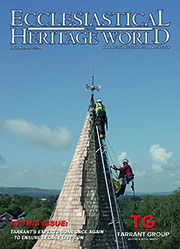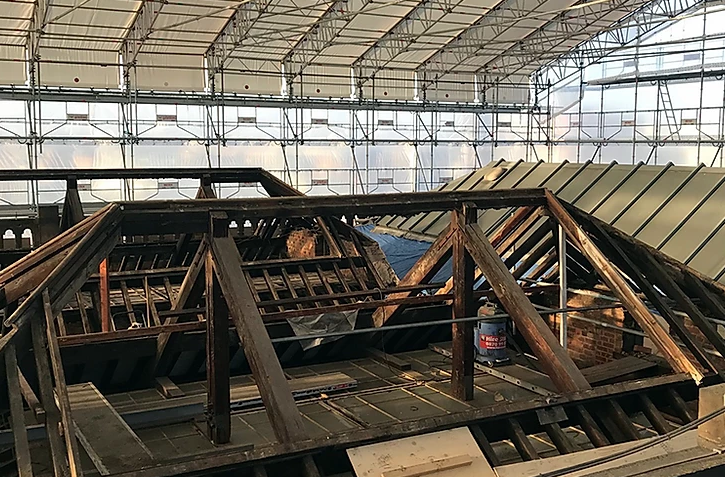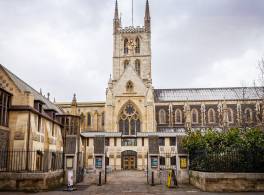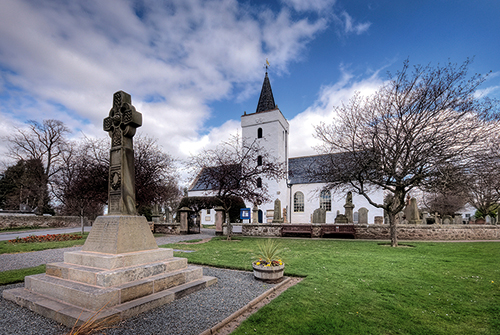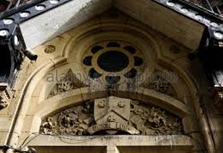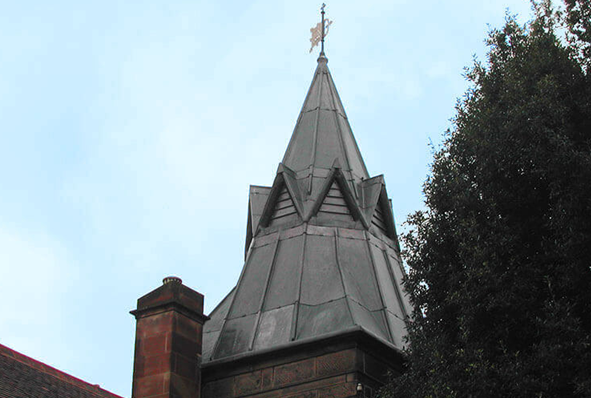Heritage Roofing
Heritage roofing - maintaining our iconic buildings
The UK is home to some of the most iconic buildings in the world, from stunning churches and cathedrals to historic stately homes. Each and every one of these remarkable feats of architecture requires regular maintenance to ensure they remain in the very best condition, allowing them to be enjoyed for generations.
Cathedral Care
Restoration and upkeep of cathedrals
There are some 42 Anglican cathedrals in the UK, not to mention 20 or so Catholic cathedrals. Cathedrals form the most important collection of historic buildings in England. The largest and most ancient are internationally famous, the smallest are usually among the most significant buildings in their region and even the most recent are architectural masterpieces.
Master Craftsmen
Championing our heritage with modern craftsmanship
Twenty years ago, English Heritage (now Historic England) published its first-ever Register of Buildings at Risk across England, which featured nearly 2,000 buildings and monuments that were ‘neglected, broken and unloved’. Recently Historic England was delighted to announce that over two-thirds of those buildings were now safe, in both urban and rural areas right across the country.
Lightning Protection
When lightning strikes are you protected against this act of God?
The issue of lightning protection in churches is one that has exercised this publication for many years. In this four-part series of spotlights on the issue we will be revisiting various aspects of the subject, beginning with an overview of current thinking.
Traditional Lime
Lime: it’s better for buildings – and for the environment
It is now fairly well known that cement is not good for old buildings and that lime mortar should be used. But why? What are the advantages and what are the disadvantages? In order to begin to answer those questions it is necessary to understand the nature of traditional building, the process by which buildings used to be built, and how it differs from modern construction, the process by which we build today.
Audio Visual
Audio visual equipment in church buildings
This guidance is issued by the Church Buildings Council under section 55(1)(d) of the Dioceses, Mission and Pastoral Measure 2007. As it is statutory guidance, it must be considered with great care. The standards of good practice set out in the guidance should not be departed from unless the departure is justified by reasons that are spelled out clearly, logically and convincingly.
Read More...
LPOW Grants
£23 million government package to support restoration of thousands of listed places of worship
Heritage Minister Sir Chris Bryant has announced that the Listed Places of Worship Grant Scheme will be extended into the next financial year, providing £23 million so that thousands of historical buildings, including churches, synagogues, mosques and temples, can carry out restoration work.
CRE Events
Exhibitors enthuse over the CRE experience
By 4pm on the first day of CRE 24 at the Marshall Arena in Milton Keynes, exhibitors Chris and Kim Dunphy had already had so many helpful and detailed conversations with visitors that they were “completely talked out”.
Insurance
You need to ensure that reasonable precautions are in place at your church to keep it safe for those who use it. To do this, you need to think about what might cause harm to people.
You will then need to decide if the precautions already in place are adequate. If they are not, you may need to identify further action to prevent any danger. When done formally, this is known as a risk assessment.
Church Maintenance
Church maintenance and repair: Calendar of Care
Just as prevention is always better than cure, maintenance is preferable to major repairs. But, such repairs may not always be avoidable. Church Care offers a monthly guide in our coming issues Starting in Spring
We can help you understand the common problems and areas that need your special attention, and give you tips for regular maintenance schemes.
Pest Control
Michael Palin warns of pest threat to churches
Michael Palin is supporting the future of the UK’s historic churches and chapels with a voiceover for a new animated film. The 80 second animation, produced for the National Churches Trust, highlights why churches are some of the nation’s best loved buildings.
Town Halls
The history of the great Victorian Town Halls of Northern England
From industrial squalor to civic pride, the story behind some of the most impressive buildings of the North involve a unique mix of economics, grand designs and noble sentiments within communities.
Lead Roofing
Lead is one of the oldest materials in the roofing industry and is still commonly used throughout the world today.
Lead roofing is a traditional roofing method which has been used in the industry for hundreds of years, and is therefore proven to be extremely reliable. Lead roofing, and sand-cast lead, in particular is ideal for old buildings such as churches or historical renovations, whereas milled lead roofing is a mass-produced alternative, used for precision and accuracy in homes and commercial buildings alike.
SEARCH OUR DIRECTORY
Buying an old property? Why have a survey?
By Martin Hall of Hall and Ensom
Naturally you would expect me to be of the opinion that one should always have an independent building survey carried out when purchasing property. I hope that by the end of this article you will agree with me.
However if you do not have a survey, you are in the vast majority. Although a property purchase is by far the single most expensive buy any of us makes, with or without a mortgage, it is believed that less than 10% of buyers have an independent survey of any kind. This does not include the mandatory bank or building society valuation inspection. That inspection is not necessarily there to give you comfort. It’s main purpose is to ensure that the house exists - and indeed some haven’t! - and primarily that it is adequate security for the loan.
I certainly believe that anyone considering purchasing a listed or older property should have an independent survey.
In the 2008 English Home Condition survey there were 22 million houses in England and Wales, of which some 15.3 million were owner occupied and 4.8 million were built before 1919. There are 368,923 listed homes in England and Wales of which 8,920 are Grade I and 20,586 are Grade II*, and approximately 340,000 are Grade II. Not all of these will be pre-1919 but most of them will be.
English Heritage in their latest survey “Buildings at Risk Register”, indicate that 1 in 30 listed buildings are at high risk in the south East of England alone – an alarming statistic.
So what should a survey do?
The main purpose of a survey - discounting the fallback position of suing the surveyor should he get it wrong! - is to inform a purchaser of the condition of a property and give advice on repairs. This requires an understanding of the problems that can be found in the various types of historic property, from Elizabethan timber framed houses through to Victorian brick houses.
With a listed building it is particularly important to have an informed understanding of what it is you are letting yourself in for. The Society for the Protection of Ancient Buildings, S.P.A.B, suggests that an owner of a listed building is the “custodian for life.” There is an implied duty to maintain the building so that it can be passed on to the next generation in a better condition than found, and certainly not in any worse.
There is often the view that while a house has been here for 250 years it will last a few years more without doing very much to it. This is true up to a point but there will come a time in every building’s life when it needs some attention, and while there is a growing appreciation of conservation techniques and most people have at least heard of lime mortar few still understand why or what will happen if you do not use the right techniques and products. Unfortunately there are still too many builders who don’t understand conservation repair techniques and are doing more harm than good.
What are the main problems to look out for?
The most serious issue in old houses could be summed up in one word – Damp. It is the enemy of most buildings. A good roof, sound walls and well ventilated timber floors will go a long way to keeping most houses in good order.
Looking firstly at roofs: they should obviously be watertight. Felt or modern breathable underlays are not essential but do provide a second line of defence and are as a rule installed in listed buildings if the roof is re-laid. It is important to ensure that roof slates do not have nail failure, wooden pegs on your stone slates are still present and not altogether worm eaten; that the lead is sound and not leaking and that handmade clay tiles, although they may look uneven, are still doing their job satisfactorily. Uniformity does not often exist in old buildings and its absence is not a defect but part of the character.
Gutters where present should work. If the house is thatched ensure it has a drip zone – an area of gravel or garden rather than hard pavings - immediately under the thatch so that the water does not splash back up onto the walls at low level causing damp.
Chimneys: – wood burning stoves are becoming ever popular. They burn at very high temperatures and it important that the flue is lined. If the property is thatched, is the flue insulated or ventilated? Many old flues are interconnected and fumes can find their way into other rooms. Is the brick or stonework sound and well pointed? Is it stable?
Walls are usually timber-framed or solid in most listed buildings. Cavity walls came in around the turn of the 20c but solid brick and stone walls continued to be built right up to the mid to late 20c in rural parts. The main object is to support the building and keep the weather out. It has been said that if you live in a timber framed building and the frame is exposed both inside and out it will certainly leak, and this is can be the case. Are the infill panels between the timber sound? On one recent survey two of the upper brick panels between the timber box frames could be rocked backwards and forwards. Whilst decorating my own house I cleared up cobwebs below a cross beam and was able to see outside through a 10mm gap! No wonder it was draughty. Out came the lime mortar and a pointing tool and it was soon filled in.
Stone and brick walls should be well pointed in lime mortar – not cement. Soft pointing is not necessarily indicative of a defect, and how boring it is to have uniform new pointing everywhere. Keep as much of the old as possible, it is part of the history of the house and it should still last for many years to come. Many stone cottages still have signs of old lime-washing under the eaves to the exposed stonework. The stone walls were never intended to be exposed in the way that they are now. It is a product of 19th and early 20th century fashion. We obtained consent to lime wash a Grade II* house to protect the external walls and at the same time saved the owner client many tens of thousands of pounds on expensive stonework repairs. Yes it looks different but it looks as it was originally intended to.
Damp and timber treatment – beware the “specialists” peddling treatments! Silicone Injection is known not to work well in old stonewalls. Some even say there is no such thing as rising damp, many say that the treatments don’t work and are only effective because of dense waterproof cement render that comes with the replacement of existing plaster, often to the detriment of the breathability of the structure. The general conservation view is that these systems are often unnecessary and are contrary to the principle of breathablilty of stone and brick walls built with lime. Unfortunately we are too late for so many houses. If yours is one of the fortunate ones not to have had the interior plaster replaced, keep the old lime plaster. Often it is not advisable to have decorative wallpapers on ground floors that are slightly damp but there are so many breathable paint systems available now that colours are no longer so limited. Distemper or lime wash doesn’t have to be the only finish.
There were no effective damp proof courses before about 1850 and many houses pre-1919 did not have them. Lime mortar and breathable finishes all contribute to giving a satisfactory internal condition where there are no damp proof courses.
Timber ground floors should be well above ground level and have adequate ventilation.
Modern services are a very important part of old houses. Good electrical wiring is essential as is ensuring that it is up to date, compliant with the 17th Edition of the Institute of Electrical Engineers, (I.E.E), regulations and that it is regularly checked by an electrician at least every 5 years. This is always an insurance condition for thatched properties
Central heating is a fact of life these days but old houses often do not like to be hermetically sealed with high internal air temperatures: some air movement is needed. - Insulation standards cannot often be achieved in older buildings to modern building regulation standards, but there are many things which can be done to ensure that standards are brought up to a better level without damaging the character or appearance of the building.
What should a survey cost?
Typically about £750 to £850 plus vat for a small 2-3 bedroom terraced or semi-detached house and beyond that it rather depends on the size and age of the property as it is this that determines the amount of work for the surveyor. Typically this will be around £1250 to £1750 plus vat for a 3 to 4 bed house. The only real exclusion clause that should be present is the one that basically says “if I can’t see it I can’t tell you about it”. However some things can still be detected such as by smell, for dampness and dry rot; and by the feel of things such as flimsy floors, which often tell a tale or two. Typical reports are at least 20 pages long and should have a brief costed summary at the end.
Who should one use?
Well I am bound to say a chartered building surveyor, but certainly someone with some experience of old buildings and preferably a good track record and experience in conservation.
In conclusion, I hope I have been able to persuade you that the expenditure on a survey is value for money taking into account the increased risks when buying a listed or older property. Don’t take the chance – survey it.
Martin Hall, FRICS, IHBC, PG Dip Conservation of Historic Buildings, RICS Accredited Building Conservation
is a Chartered Building Surveyor in Oxfordshire. He is in practice with David Ensom MRICS a Chartered Building Surveyor in Hampshire
Their practice covers the Cotswolds, Thames Valley and Southern England. Between them they have over 60 years’ experience surveying, designing & supervision of repairs, alterations and extensions to a range of listed properties.
For more information visit www.hallandensom.co.uk









